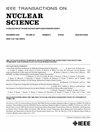A High Precision Time Measurement Method Based on Frequency-Domain Phase-Fitting for Nuclear Pulse Detection
IF 1.9
3区 工程技术
Q3 ENGINEERING, ELECTRICAL & ELECTRONIC
引用次数: 0
Abstract
This article proposes a high-precision time measurement method based on digital frequency-domain phase-fitting (DFPF) by using digitized nuclear pulses. The averaging effect inherent in the frequency-domain cross correlation and phase-fitting processes effectively minimizes measurement errors, thereby ensuring high precision and resolution in time interval measurements. In this article, the theory of this DFPF-based time measurement method is analyzed, and an electronics prototype is designed to validate the feasibility of the proposed method by utilizing analog-to-digital converters (ADCs) for pulse digitization and a field-progammable gate array for phase fitting implementation. The test results indicate that under ideal conditions with a signal-to-noise ratio (SNR) of 64 dB, this method achieves time measurement precisions of 50-, 18-, and 2.9-ps rms, corresponding to different Gaussian pulse widths and sampling rates of 118 ns at 40 MSPS, 10 ns at 100 MSPS, and 3 ns at 500 MSPS, respectively. The precision improves with increasing pulse bandwidth. Furthermore, in practical cosmic ray tests, the method achieved favorable timing performance with a precision of 1.7-ns rms. These results demonstrate that this proposed method has the potential to be a high-precision time measurement for particle detection and is equally applicable to other advanced time measurement scenarios.核脉冲检测中一种基于频域相位拟合的高精度时间测量方法
提出了一种基于数字频域相位拟合(DFPF)的高精度核脉冲时间测量方法。频域互相关和相位拟合过程中固有的平均效应有效地减小了测量误差,从而保证了时间间隔测量的高精度和高分辨率。本文分析了这种基于dfpf的时间测量方法的原理,并设计了一个电子样机,通过使用模数转换器(adc)进行脉冲数字化和现场可编程门阵列进行相位拟合来验证所提出方法的可行性。测试结果表明,在信噪比为64 dB的理想条件下,该方法在不同的高斯脉冲宽度和采样率分别为118 ns (40 MSPS)、10 ns (100 MSPS)和3 ns (500 MSPS)的情况下,时间测量精度分别为50、18和2.9 ps rms。精度随脉冲带宽的增加而提高。此外,在实际的宇宙射线测试中,该方法获得了良好的定时性能,精度为1.7 ns rms。这些结果表明,该方法具有成为粒子检测高精度时间测量的潜力,同样适用于其他高级时间测量场景。
本文章由计算机程序翻译,如有差异,请以英文原文为准。
求助全文
约1分钟内获得全文
求助全文
来源期刊

IEEE Transactions on Nuclear Science
工程技术-工程:电子与电气
CiteScore
3.70
自引率
27.80%
发文量
314
审稿时长
6.2 months
期刊介绍:
The IEEE Transactions on Nuclear Science is a publication of the IEEE Nuclear and Plasma Sciences Society. It is viewed as the primary source of technical information in many of the areas it covers. As judged by JCR impact factor, TNS consistently ranks in the top five journals in the category of Nuclear Science & Technology. It has one of the higher immediacy indices, indicating that the information it publishes is viewed as timely, and has a relatively long citation half-life, indicating that the published information also is viewed as valuable for a number of years.
The IEEE Transactions on Nuclear Science is published bimonthly. Its scope includes all aspects of the theory and application of nuclear science and engineering. It focuses on instrumentation for the detection and measurement of ionizing radiation; particle accelerators and their controls; nuclear medicine and its application; effects of radiation on materials, components, and systems; reactor instrumentation and controls; and measurement of radiation in space.
 求助内容:
求助内容: 应助结果提醒方式:
应助结果提醒方式:


